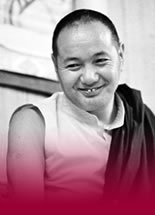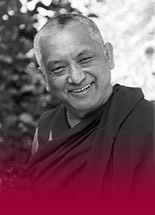Robina’s Blog
14 April, 2022
When we get into the deeper levels of Buddha’s analysis of how things exist and we hear that the fundamental cause of our suffering is our primordial grasping at our self (and everything else) as having an inherent nature; and then we hear that it doesn’t have this type of nature, it utterly lacks it; that in fact nothing could exist if it did have it; and that in order to quit suffering we need to realize this lack, this absence, this emptiness of an inherent, independent, intrinsic self and everything else – when we all hear this, we get pretty confused.
Emptiness? The first thing that comes to mind is that it means nothingness. “Oh, no, there’s no self, so why bother!” We chuck the baby out with the bathwater. We fall into the abyss of the great mistake, as Tsongkhapa says.
Let’s look at the meaning of this word in our daily lives. Let’s say I go to drink my tea and as I’m tilting the cup towards my lips I get a surprise: “Oh, my cup’s empty!”
Or you’ve been invited to a party and you open the door and you’ll get a surprise: “Oh no, the room’s empty!”
You go online and log in to your bank account to check on your five thousand dollars that you’ve been saving, and when zero appears you’ll be shocked: “Oh, no, my bank account is empty!”
But these absences are not nice ones. A better example would be if you are told you’ve got cancer. You’re devastated. You come to terms with it, that you’ll die soon, and the rest. And then your doctor tells you that actually you got the wrong x-rays, that there is no cancer after all. “Wow! I don’t have cancer!” This is a delicious emptiness to realize!
In each case the crucial thing to see is that we expected something to be there, we totally anticipated the tea, the people, the five thousand dollars, the cancer. So the truth that we realized was the lack, the absence, the nonexistence, the emptiness of the very thing we totally assumed was there, that we expected to be there.
We didn’t simply see nothingness. That's the difference, the big difference. That's the massive difference. When you go to buy some cups in the shop you don’t get a surprise when you discover there’s no tea in them! You don’t expect tea!
If you ask me to check your bank account I’ll simply see the truth: zero dollars. Now, that’s nothingness: simply no dollars. I see nothing, zero, but that’s not what you see – you see the absence of your precious five thousand dollars. Two very different phenomena!
But there’s more to it. Let’s say Kate is color-blind and whenever I show her my black thermos, she sees pink. It’s always been like that for her and so naturally she just assumes it’s true that it’s pink; she never doubts it. She’s shocked when you tell her that actually it’s not pink, but no matter how often she hears she’s making a mistake, it’s hard to realize it because pink actually appears to her. She totally believes it’s pink.
So we decide to help her get her eyes fixed. Now her eyes are fixed and we show her the black thermos again. What’ll she see now? She'll get the shock of her life! “Oh no, it’s not pink!” We assume that she’d finally see the truth, the black thermos – no! What she sees is the absence of pink, the emptiness of pink, the emptiness of what she thought was there.
So what’s Buddha telling us? He’s saying we believe utterly, without question, in the presence of a certain kind of me in here, among all the bits and pieces of my body and mind – an inherent me, an intrinsic me, an independent me, a me that doesn’t depend on anything, a me that runs the show.
Clearly, this kind of emptiness is way more radical. I mean, tea could exist in my cup, people could exist in that room, five thousand dollars could exist in my bank account, cancer could exist in my body, pink could exist on that thermos. But an independent, inherent, intrinsic self has never existed, doesn’t exist, and could never exist on these aggregates. Not possible!
No one’s ever pointed out that mistake to us because that’s what we all believe. We’ve believed in it for countless lifetimes, and it automatically gives rise to attachment, anger and the other neuroses, which in turn cause us to make a mess of lives, harm others, and so on.
As Lama Zopa Rinpoche says, it’s bad enough that this primordial mistake causes the self to appear to exist in there somewhere, pointable, real, findable, the killer is that we believe it is true. That’s what traps us utterly.
As Pabongka Rinpoche advises, even if we don’t know what emptiness means, we need to think, “Maybe things don’t exist in the way they appear.” Just this doubt puts atomic bombs under ego-grasping!
One day we will have our first moment of direct, nonconceptual cognition of this fact in the subtlety of our super-concentrated state of samadhi.
For the greatest yogis, Lama Zopa Rinpoche says, this realization is utterly joyful! Finally, the truth is evident, the truth that has always been there, but which they’ve been blinded from seeing until now.
From that moment, we will have cut the root of samsara, the assumption of the real me, and attachment, anger and the rest, its main voices, will just wither away. And we will have cut fear.
We will still have plenty of work to do, but we can’t fall back after that.

